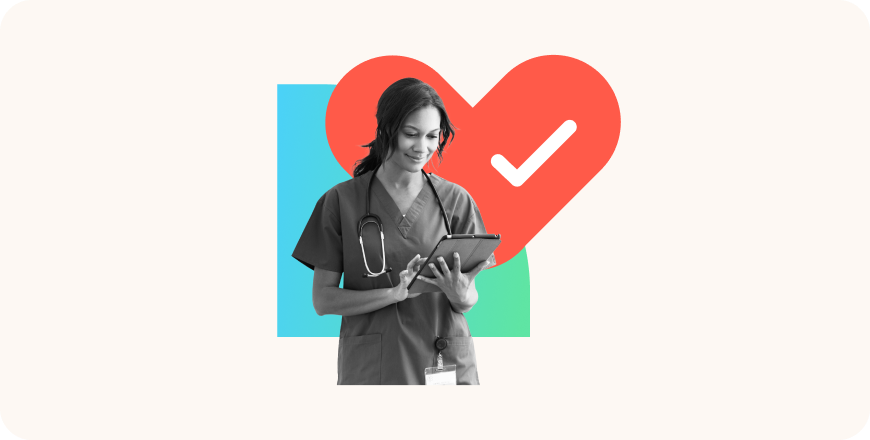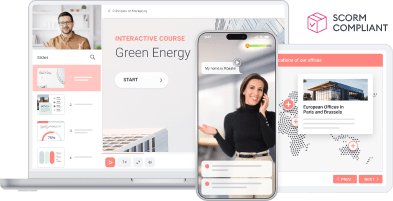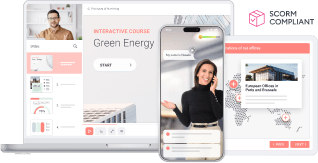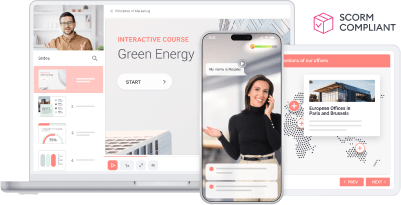eLearning for Healthcare: Best Practices and Ideas for 2025

Healthcare systems around the world are grappling with staff shortages, aging populations, and rapid technological advances ranging from AI-driven diagnostics to telemedicine. These pressures call for flexible, efficient eLearning for healthcare teams to master new tools, reinforce core skills, and comply with evolving standards.
In this article, you’ll discover how eLearning benefits healthcare organizations, explore real-world examples, and learn best practices for designing programs that keep pace.
Why eLearning is Great for Medical Education
Healthcare professionals face new standards and technologies daily that require quick, flexible ways to adapt on the go. eLearning solves this, offering efficient, accessible medical education. Here is how it impacts the fast-paced healthcare industry.
Provides flexibility for demanding schedules
Healthcare professionals face unpredictable hours, long shifts, and high-pressure environments. Traditional training methods often don’t fit their packed routines. Here are ways that eLearning makes training accessible and stress-free:
- It offers staff 24/7 course access so they can learn during a quiet night shift or between patient rounds.
- Multi-device compatibility ensures that training is accessible on desktops, tablets, or smartphones — whenever and wherever it’s needed.
- Self-paced learning allows professionals to progress at their own speed, integrating education into their day without disruptions.
Ensures consistency and standardization with content
Traditional training often varies by instructor or location, leading to inconsistent results. eLearning can help you deliver standardized content to all learners because:
- Every learner gets the same materials, ensuring unified knowledge across teams and reducing gaps.
- Administrators can quickly update protocols or guidelines to align training with the latest standards.
- Courses can be customized for specific regions or teams without losing global consistency.
Scalable for any number of people
Training in the healthcare sector often involves large groups, from clinical staff to administrators. eLearning solves this challenge thanks to its scaling opportunities:
- eLearning platforms easily handle thousands of learners, helping you upskill entire hospital networks or departments without additional effort.
- New hires can access training immediately, giving clinical staff immediate access to lifesaving protocols and procedures.
- Large-scale updates, like new compliance rules or medical guidelines, can reach all staff quickly, no matter how many there are or where they’re located.
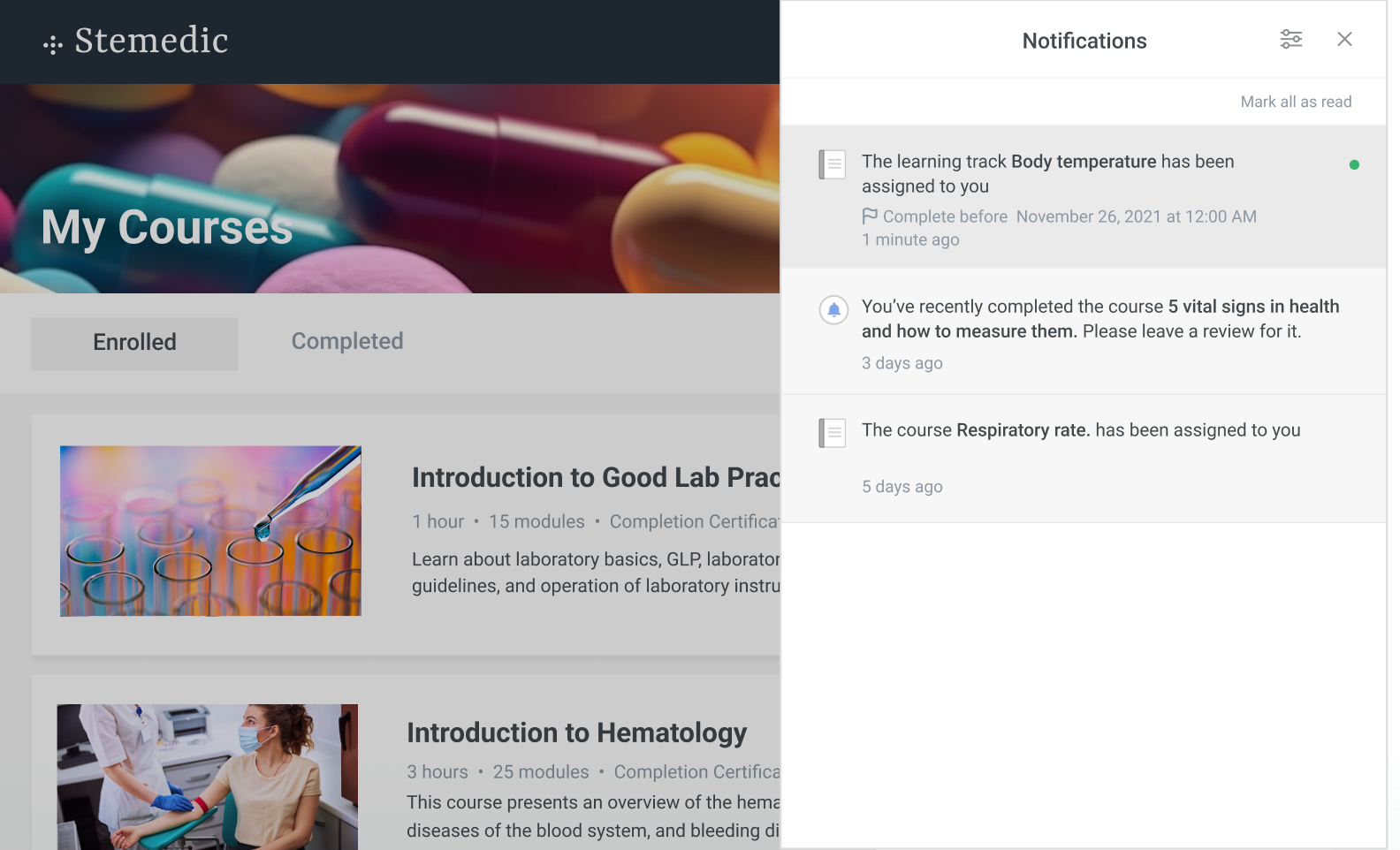
Gives learners ongoing access to key resources and information
In healthcare, quick access to accurate information can make a life-saving difference. Online learning ensures that healthcare professionals always have the learning materials they need at their fingertips:
- Learners can revisit training modules anytime to reinforce knowledge and maintain essential skills.
- Resource libraries can include practical tools like checklists, guides, and videos that support day-to-day tasks.
- On-demand access to trusted information helps staff make informed decisions quickly in high-stakes situations.
Promotes collaboration among hybrid and remote teams
Teamwork among healthcare professionals is essential for delivering safe and effective patient care. eLearning bridges the gap for dispersed teams with:
- Virtual classrooms that enable real-time interactions, bringing healthcare professionals together for live training sessions with instructors and colleagues around the world.
- Discussion forums and collaborative learning environments, where teams can exchange ideas, ask questions, and tackle challenges together.
- Team-based learning modules and simulations, like emergency response or patient care planning, that help teams build trust and strengthen clinical competence.
Learn more about how to implement online training in the healthcare industry effectively to meet the unique demands of medical professionals.
Use Cases for Healthcare eLearning
The possibilities are endless with eLearning. From onboarding to technical skill training, the healthcare industry leverages online courses in a number of ways. We’ve put together some success stories to inspire you and show how eLearning can benefit your healthcare workforce.
1. Train healthcare employees to upgrade their professional skills
Healthcare professionals worldwide have to keep up with the latest techniques and technologies and expand their knowledge and skills regularly, which makes continuous learning vital in such a dynamic sector. As a result, an increasing number of organizations provide online learning for health professionals. Let’s take Learning Nurse as an example.

Learning Nurse is an informal healthcare education platform for nursing students, practicing nurses, and nursing educators. Its goal is to provide learners with access to educational nursing material anytime, anywhere.
The company adopts a quiz-based learning approach to train nurses. Once learners have studied the material and completed quizzes, they receive customized certificates. This is a hugely important factor for the organization because the certificates are used for selection and employment screening.
2. Onboard staff in healthcare-related sectors
The healthcare industry covers a wide range of job roles, including doctors and healthcare providers, clinical research companies, pharmaceutical companies, and medical device manufacturers. Many of these healthcare institutions have a large and dispersed workforce. eLearning allows them to digitize their onboarding packages to create an engaging and seamless online learning experience. One such organization is PSI.

PSI is a full-service clinical research organization with over 2,300 employees across the globe. It had been conducting monthly, labor-intensive, instructor-led induction sessions and carrying out training activities in 50 different locations.
Since this required a great deal of resources, the company revamped its induction program and moved it online with the iSpring Suite authoring toolkit. The new program is more interactive, personalized, and engaging for new hires. Moreover, moving to a fully digital induction package has freed up valuable time for SMEs, cut training costs, and ensured global consistency in training.
3. Provide employee compliance training
The healthcare industry has strict compliance standards and regulations. This necessitates that organizations provide employees with up-to-date compliance training and ensure those standards are met. Many large companies, like Unichem Laboratories Ltd., have multiple locations worldwide, making instructor-led sessions a labor-intensive and costly option.

Unichem Laboratories Ltd. is one of India’s largest and longest-running pharmaceutical companies. With over 3,200 employees, it needed an effective way to deliver ongoing employee training to comply with numerous industry standards and regulations.
Using the iSpring Suite authoring solution, the company converted over 900 standard operating procedures into digital courses that allowed it to train its 3,200 employees in a quicker, more cost-effective way.
4. Train customers and distributors
Not reserved only for doctors and nurses, healthcare courses are also used to train customers and distributors on medical technology. These online courses allow partners to learn about the features and benefits of medical equipment and let patients use health devices like blood pressure cuffs, glucometers, and activity trackers more efficiently.

IMT MatcherTM provides IVF management technologies and quality management systems to fertility centers, donor banks, and other Assisted Reproductive Technology (ART) centers. When its face-to-face training model became too time-consuming and costly to manage the organization’s rapidly growing customer base, it began the search for an eLearning platform. The company now uses iSpring Learn to train customers and distributors all over the world, growing their international customer base and cutting training costs by 25%.
5. Deliver accessible training to even the most remote locations
Thanks to eLearning, medical training is now more widely accessible. Online courses can be shared with industry professionals in remote or low-income countries easily to make sure they receive the lifesaving information they need. FYMCA does just that.

After experiencing the impact of rare diseases first-hand, FYMCA was formed to help doctors and healthcare providers in low-income countries get relevant healthcare education and be able to provide high-quality treatment. The company focuses on teaching doctors and healthcare staff how to diagnose rare diseases and treat and manage their patients.
FYMCA now trains doctors around the globe, delivering vital knowledge via the iSpring Learn learning management system. iSpring’s free mobile app allows learners to save content on their mobile devices and access it when convenient, even when they’re offline. The LMS tracks and updates the results when it’s back online.
Effective eLearning for Healthcare Professionals with Instructional Design Methods
Effective training goes beyond simply delivering information — it must foster critical thinking, enhance clinical skills, and refine patient care practices. Below are three key techniques that create a practical and well-rounded training program.
Memorization
In high-stakes healthcare settings, quick recall of essential knowledge can save lives. To improve memorization and retention, structured and engaging content is key. Here are some strategies that enhance recall:
- Break complex topics into smaller parts to teach one concept at a time. For instance, divide a course on medication safety into segments like dosage calculations and contraindications.
- Revisit key concepts regularly with flashcards or short quizzes on infection control to keep knowledge fresh.
- Use interactive assignments, exercises, and quick assessments to test learners’ recall instead of relying on passive reading.
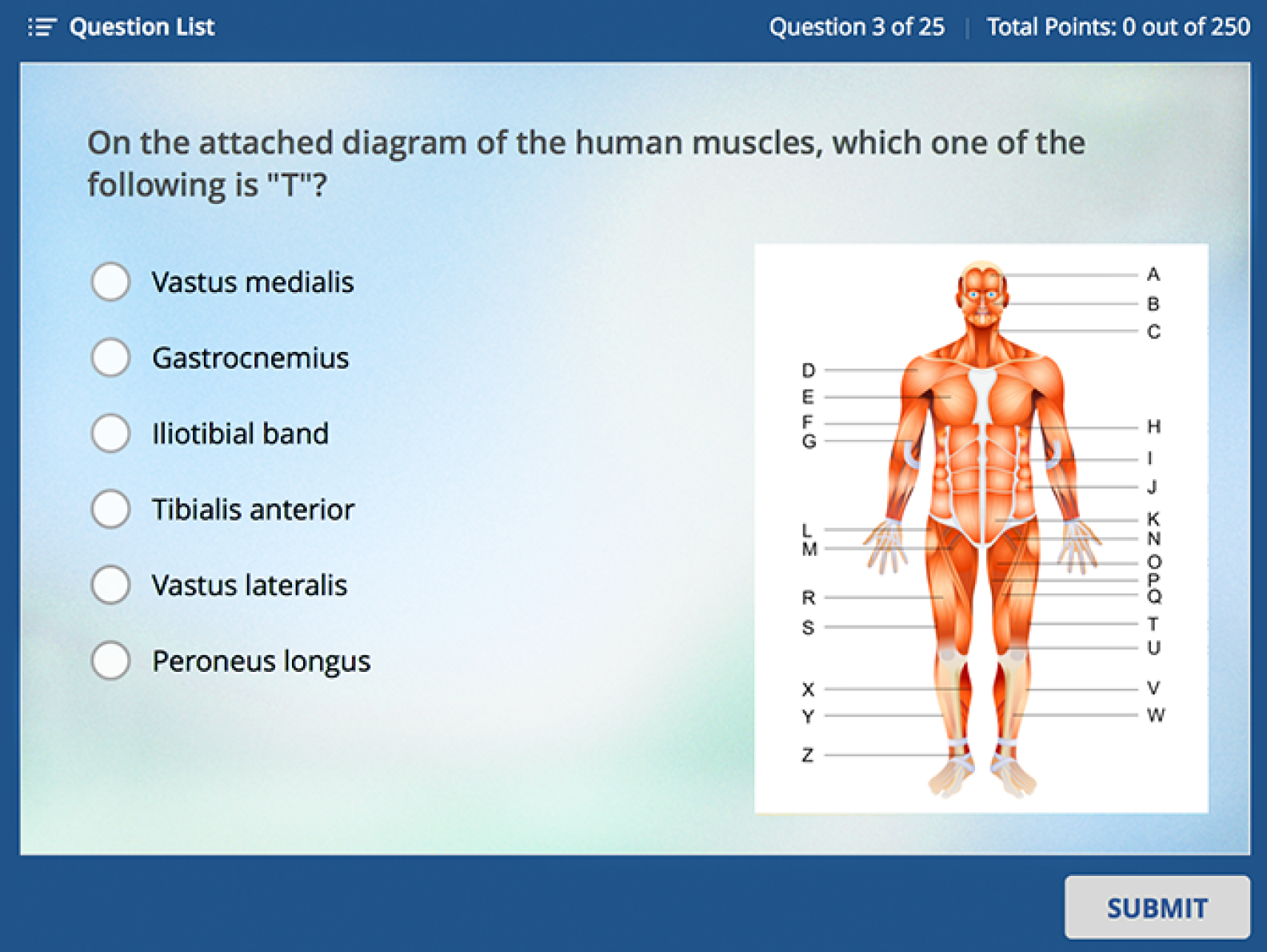
A screenshot from a quiz created by Learning Nurse.
Critical decision-making
Healthcare professionals make life-or-death choices daily, so they need strong analytical skills to respond effectively under pressure. eLearning can incorporate practical techniques to strengthen these skills by:
- Challenging learners with patient cases and requiring them to diagnose, choose treatments, or decide between tests like an ECG or an X-ray.
- Providing hands-on simulations like cardiac arrest drills that offer immediate feedback on critical steps like CPR or medication administration.
- Giving instant feedback and explaining the rationale for correct actions to ensure that lessons are clear and memorable.
Empathy, listening, communication
Empathy, clear communication, and other soft skills are as vital as clinical knowledge. They foster patient trust, enhance teamwork, and lead to improved patient outcomes. Сonsider implementing the following strategies:
- Practicing tough conversations with role-play scenarios like delivering a diagnosis to build confidence in handling sensitive topics.
- Showing examples in video lectures to demonstrate faulty and effective communication, such as active listening during patient consultations.
- Allowing learners to record and review their responses, helping them identify gaps and refine their communication style.
To support healthcare professionals with robust training solutions, choose the best LMS for healthcare, tailored to meet the industry’s unique challenges.
The 7 Best Practices for eLearning in Healthcare
Healthcare professionals operate in time-sensitive environments where continuing medical education is essential. A strategy of well-structured eLearning courses offers a scalable and flexible solution to meet these needs, improving skill development while ensuring compliance with evolving regulations. Below are practical steps and strategies to create eLearning programs for the healthcare sector.
1. Consider your audience’s needs
Healthcare eLearning isn’t a one-size-fits-all proposition. Nurses might need help with patient communication, while technicians require training on using medical equipment. By tailoring training to specific roles, you can make learning practical, relevant, and effective.
Steps to identify and meet audience needs
- Divide your audience into groups, i.e., nurses, technicians, or administrators. Use surveys and feedback to identify skill gaps and learning preferences, and then have them practice exercises related to skills or information they might need.
- Design courses that let learners pick topics that are most useful for them. For example, nurses could focus on advanced life support, while administrators might study compliance protocols. Use real-life scenarios to make the training stick.
- Develop mobile-friendly courses that professionals can complete during breaks or between shifts. Test the course on phones, tablets, and desktops to ensure it works smoothly. For example, an emergency response module should be quick and easy to access on mobile devices.
2. Enhance your courses with microlearning
Microlearning involves short and focused lessons that fit into busy schedules. These quick modules help healthcare professionals learn during breaks, improve retention, support continuous learning, and immediately apply new skills in their work.
Designing effective microlearning modules using the SMART framework
- Specific: Focus on one topic per module, such as “Hand hygiene to prevent infections.”
- Measurable: Add quizzes or practical tasks to assess understanding.
- Achievable: Keep lessons concise — 5 to 10 minutes is optimal.
- Relevant: Address critical needs, like compliance training or emergency protocols.
- Timely: Make content suitable for brief downtimes, such as between patient rounds.
An authoring tool will help you quickly design interactive, concise lessons to meet the needs of busy healthcare professionals. The iSpring Suite authoring tool uses the familiar PowerPoint interface, so you can start designing courses without extra training. With interactive tools like quizzes and scenario-based exercises, you can build lessons that help your healthcare employees practice and apply critical knowledge right away.
3. Measure engagement regularly
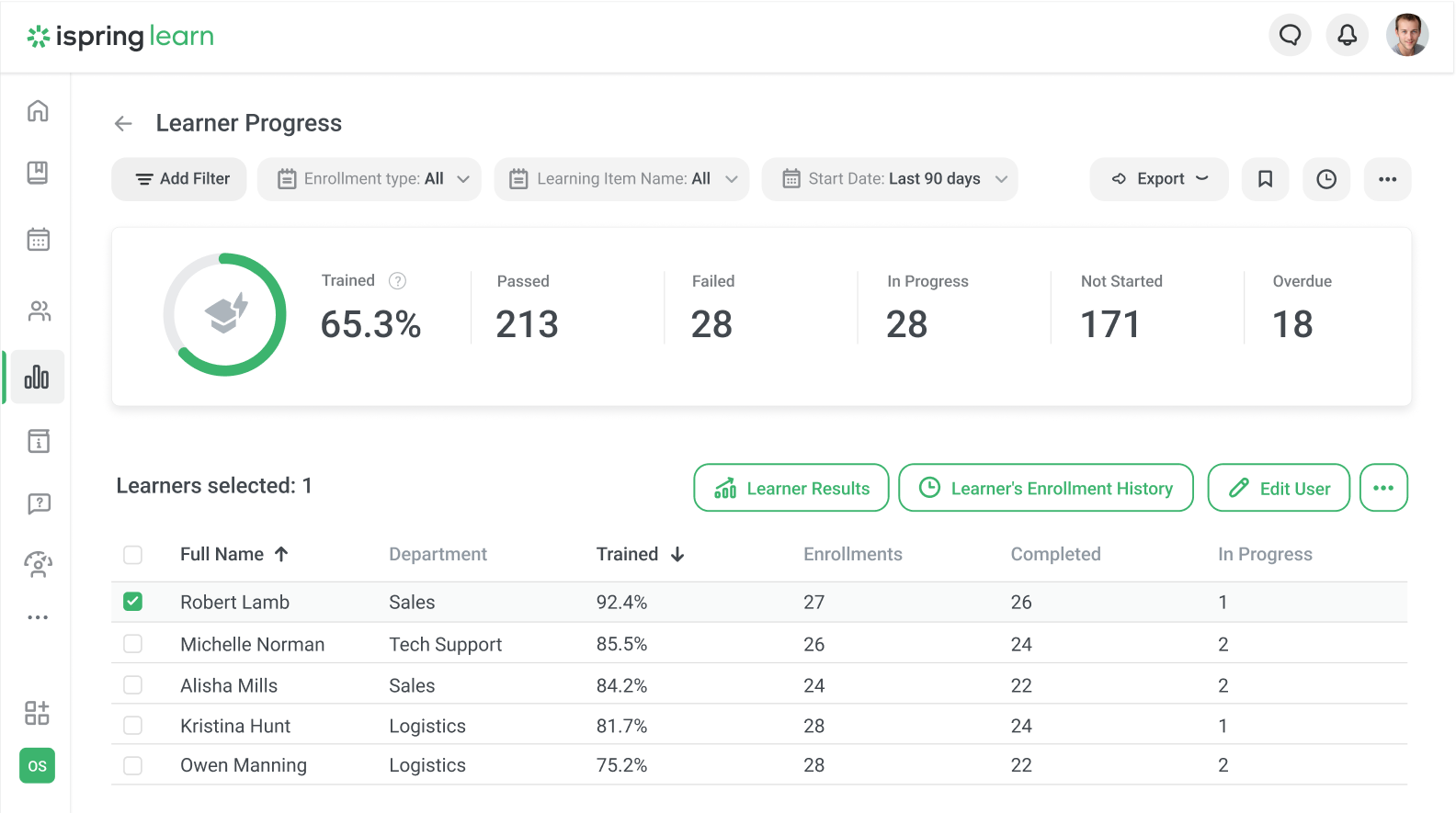
By monitoring how participants interact with your content, you can pinpoint gaps quickly to fine-tune your approach. Here are five important signs to watch for when assessing and improving engagement:
- Completion rates reflect whether your material is relevant and clear. High rates suggest a strong connection with learners, while lower rates may signal modules that are too lengthy or confusing.
- Time spent on modules indicates the depth of learner involvement. If people speed through crucial topics, shorter lessons or added interactivity may help.
- Quiz and assessment performance reveals if your content is too challenging or not challenging enough. Adjust difficulty levels to align with learning goals.
- Drop-off points highlight where learners abandon a course. Simplify or enrich content at these moments to keep them moving forward.
- Direct feedback through surveys, polls, or pop-up questions can show whether your course meets expectations for clarity, relevance, and difficulty.
A dedicated learning management system helps you gather real-time analytics, spot areas where learners struggle, and make quick adjustments to boost participation. iSpring Learn is an LMS with a user-friendly dashboard that flags modules with high drop-off rates or quiz failures, so you can refine them before minor issues escalate.
4. Prioritize evergreen content
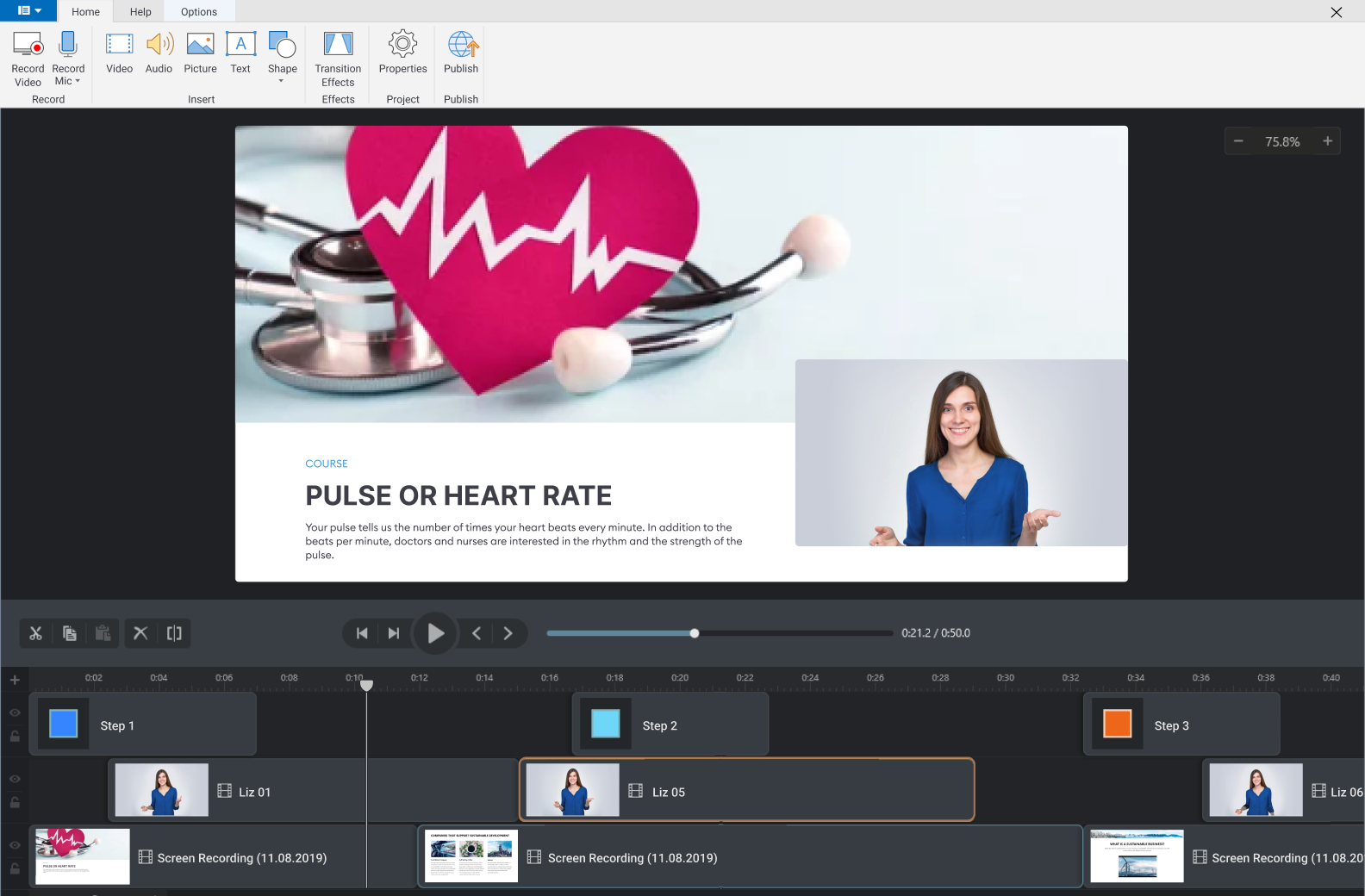
Evergreen content focuses on enduring principles like infection control, patient safety, and medical ethics that remain vital. By building your course content around these lasting topics, your training will retain its impact for years to come. Below are ways to develop and maintain evergreen courses:
- Start with a high-quality, scalable design. By using consistent templates, you maintain a unified look and simplify updates — especially important when regulations or guidelines change. Once your framework is in place, an authoring tool like iSpring Suite helps you create and reuse these templates, saving time while keeping all your training materials on brand and up to date.
- Adopt engaging, flexible formats. Combine video tutorials to demonstrate procedures, downloadable guides for quick reference, and infographics to simplify complex workflows. These formats are easy to update, enhancing understanding without requiring complete overhauls. For example, an infographic on infection prevention can be refreshed quickly to reflect new guidelines.
- Implement a proactive update strategy. Schedule regular reviews, such as annual audits, to identify outdated content. Collaborate with subject matter experts to keep materials aligned with current standards and practices. Instead of rewriting entire courses, add microlearning updates. For example, a 5-minute module on new compliance regulations can integrate into existing training seamlessly.
5. Update to meet changes
While evergreen topics anchor your training, healthcare regulations change frequently, requiring prompt course updates to ensure compliance with standards like HIPAA or OSHA. Keeping training materials up to date protects your organization from legal and operational risks and fosters trust among healthcare professionals.
How to build a robust maintenance strategy
- Collaborate with subject matter experts (SMEs) and assign them specific responsibilities, such as reviewing compliance updates or validating new medical protocols. Their expertise ensures content alignment with the latest regulations and industry practices.
- Adopt a modular course structure to update specific sections, like compliance standards, without overhauling the entire course.
- Use a learning management system for automation and ensure that staff always see the latest materials, keeping you compliant, building trust, and freeing up valuable time. iSpring Learn employs content version control to deliver up-to-date courses and send automated reminders when protocols change to focus your staff on what matters most — delivering quality patient care.
6. Measure the impact on patient care
eLearning in medicine is not just about learning but first and foremost about applying knowledge to patient care. To measure the impact of learning in this way, it’s important to adopt a structured approach:
- Highlight key patient care metrics. For example, track how training on drug prescription protocols reduces medication errors. Measure the number of incidents for three months after implementing the medication administration module.
- Collect patient feedback through surveys and forms. These are used to assess changes in subjective measures such as empathy or clarity.
- Plan for the long term. For example, set targets for reducing readmissions, improving retention, and operational efficiency. This will help you see the bigger picture.
7. Plan for robust supporting material
Quick-reference guides, interactive tools, and videos are essential resources for healthcare professionals, providing instant access to critical information and improving confidence in decision-making. These tools simplify complex concepts, making knowledge easier to apply in high-pressure situations. To create effective supporting materials, follow these principles:
- Use LMS data to pinpoint struggling learners by analyzing low-performing or frequently revisited modules. Feedback from healthcare staff can also reveal which tools they need most, such as step-by-step tutorials for medical devices or quick guides for emergency procedures.
- Match formats to the scenario for maximum impact. Quick-reference guides provide portable, actionable steps for emergencies, while infographics simplify workflows into clear visuals for healthcare professionals. Tailored formats ensure materials are practical and easy to use in real-world settings.
- Organize materials in a centralized learning management system library. A well-structured repository helps healthcare staff find updated protocols, guides, and other vital resources quickly. Offline functionality is also key — especially in remote or low-connectivity settings. iSpring Learn offers a built-in knowledge base where all training assets and references are under one roof.
Final Thoughts
The industry landscape is evolving faster than ever, and eLearning for healthcare continues to be a flexible, cost-effective way to keep teams ready for whatever comes next. By delivering high-quality, accessible courses, you empower professionals at all levels — from new hires to seasoned specialists. Whether you’re onboarding healthcare professionals or providing advanced medical training, online education has proven to boost skill retention, support compliance, and ensure better patient outcomes.

As part of the lifelong learning revolution, eLearning empowers professionals to adapt to emerging challenges, stay informed of the latest advancements, and provide care of the highest quality. This revolution isn’t just about education — it’s about transforming how we approach growth and expertise in critical fields like healthcare.
Still haven’t tried iSpring Suite Max? Start creating compelling courses today with a 14-day free trial.
If you want a user-friendly LMS with powerful analytics, enhance your healthcare services with iSpring Learn to provide top-quality training, even in the most challenging environments!


